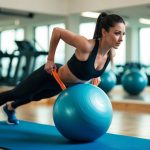
Stretching and Performance Metrics
Understanding the influence of stretching on athletic performance requires examining its effects on specific activities. Key areas include the impact of stretching on both vertical jump and sprinting capabilities. Regular stretching might also offer long-term performance advantages by enhancing range of motion and injury resistance.
Effect of Stretching on Vertical Jump and Sprinting
Stretching, especially dynamic stretching, can enhance vertical jump performance. Dynamic stretches like leg swings or lunges activate muscles and increase blood flow. This prepares the body for explosive efforts required in jumping. Static stretching, typically performed by holding a position, may have a temporary relaxing effect on muscles.
When it comes to sprint performance, flexibility is crucial. Dynamic stretches help maintain high energy output by keeping muscles active and loose. This can potentially reduce the risk of strains. On the other hand, extensive static stretching before sprinting may decrease force production, affecting speed.
Long-Term Performance Benefits of Regular Stretching
Consistently practicing flexibility exercises may lead to overall enhancements in performance over time. Regular dynamic and static stretches can contribute to increased joint flexibility and muscle elasticity. This results in more efficient muscle contractions during athletic activities.
Maintaining flexibility through consistent stretching practices not only aids performance but can also play a role in reducing injuries. Flexible muscles better withstand the physical demands of sports. This decreases the likelihood of strains which can hinder an athlete’s potential. It underscores the importance of integrating stretching into training routines for sustained performance benefits.
Risks and Management of Stiffness and Soreness
Stiffness and soreness are common after exercise or physical activity. They can signal either a normal adaptive response or an indication of potential injury. Recognizing how to manage stiffness and muscle soreness, like Delayed Onset Muscle Soreness (DOMS), is crucial for recovery and injury prevention.
Distinguishing Between Good and Bad Stiffness
Good stiffness often results from muscle adaptation and recovery following exercise. It generally manifests as mild discomfort and gradually improves with movement. This type of stiffness can indicate positive muscle growth and increased flexibility over time. Bad stiffness, on the other hand, might be associated with muscle strains or overuse, leading to sharper pain and restricted movement. Early identification helps determine whether rest, stretching, or medical consultation is needed.
Muscles that experience prolonged or severe stiffness might benefit from targeted interventions. Strategies like regulated physical therapy, consistent stretching routines, and hydration can help alleviate and manage symptoms. While mild stiffness can contribute to improved performance, persistent cases could require professional evaluation to rule out any underlying issues like muscle tears or strain.
Managing Delayed Onset Muscle Soreness (DOMS)
DOMS typically appears 24 to 72 hours after physical activity. It is characterized by muscle tenderness, stiffness, and decreased range of motion. To manage DOMS, gradual progression into exercise routines and ensuring proper warm-up and cool-down sessions are effective preventive measures. Techniques like foam rolling and massage may help reduce discomfort.
Rest and active recovery are beneficial to managing soreness effectively. Engaging in low-intensity activities like walking or swimming can support muscle recovery without introducing further strain. Over-the-counter pain relievers may provide temporary relief, but they should be used cautiously to avoid masking serious issues. Optimal nutrition, including protein intake and hydration, also plays a role in minimizing symptoms and facilitating muscle repair.
Flexibility and Balance in Special Populations
Special populations, such as older adults and individuals with disabilities, benefit significantly from focused interventions targeting flexibility and balance to enhance their quality of life and reduce risks such as falls and injuries.
Flexibility Interventions for Older Adults
As people age, their muscles and joints can become less flexible, which may lead to an increased risk of falls. Flexibility exercises, such as stretching, yoga, and tai chi, can help maintain and even improve range of motion. These exercises promote better posture and reduce stiffness, which contributes to improved balance.
Older adults often find group classes beneficial as they provide social support and motivation. Consistent practice helps in retaining muscle elasticity and joint mobility. Health professionals recommend incorporating flexibility exercises into a regular fitness routine, aiming for at least three times a week. This consistency can lead to noticeable improvements in balance and overall physical stability.
Adaptive Programs for Individuals With Disabilities
For individuals with disabilities, personalized programs focus on enhancing both flexibility and balance, tailored to their specific needs and limitations. Activities like adaptive yoga and swimming can be modified to cater to various physical capabilities, providing a safe environment to develop these skills.
Specialized equipment, such as balance trainers or resistance bands, might be used to facilitate exercises. Trained instructors play a crucial role in guiding these individuals, ensuring exercises are performed correctly and safely. Regular participation in adaptive programs can lead to more independence in daily activities, reduced risk of falls, and increased self-confidence in physical abilities. These improvements are essential for enhancing overall quality of life.



